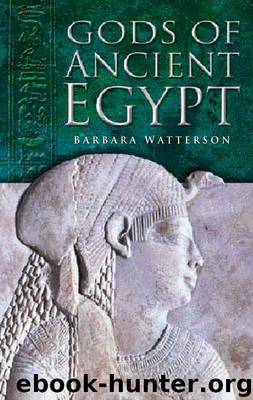Gods of Ancient Egypt by Barbara Watterson

Author:Barbara Watterson
Language: eng
Format: epub
Publisher: The History Press
SETH
Seth was one of the oldest Egyptian deities. In predynastic times, he was worshipped as an idol that seems to have been assembled from the features of several animals into an elegant imaginary beast, the so-called ‘Seth-animal’ – a creature that has the body of a greyhound; a long, fork-ended tail standing upright from its body; an elongated, curved muzzle or snout; long, pricked-up ears with flattened tips; and almond-shaped eyes. It has been suggested that the Seth-animal was a species of dog, now extinct but resembling a saluki; or a pig, a jerboa, a giraffe, an ant-eater, a wart-hog or an okapi! However, there is no known zoological equivalent for the fabulous Seth-animal.
The earliest centre of the cult of Seth was at Nbt, which lay on the west bank of the Nile some 30 km north of Luxor near the modern town of Tukh. Nbt was close to the entrance of the Wadi Hammamat through which the Eastern Desert with its gold deposits could be reached. It was probably due to gold that the town achieved its importance, a fact that is reflected in the name of the place – Nbt means ‘Gold Town’. Seth himself was called Nbty, ‘He-of-Gold-Town’. The importance of Nbt dates back to the predynastic era; some of the oldest settlements of Upper Egypt have been found in the area, notably at the nearby site of Naqada, which the English Egyptologist Flinders Petrie (1853–1942) excavated in AD 1895, afterwards using the name to describe the last two predynastic cultures of the whole of Upper Egypt, Naqada I and II.
Other predynastic centres of the cult of Seth were found in northern Upper Egypt, two major sites being in the 11th and 19th Nomes. The original nome standard of the 11th Nome consisted of a Seth-animal on a pole. In dynastic times, this animal was depicted with a dagger sticking into its head, a sign that by this time Seth was regarded as a force for evil, and his animal as potentially harmful. This aspect is reflected in the ancient Egyptian name for the capital of the 11th Nome, Sha-stp, which means ‘The Pig [i.e. Seth]-is-Pacified’. The Greek name for the town was Hypselis; today it is called Shutb. It lies some 8 km south of Assiut.
The capital of the 19th Nome of Upper Egypt, Pr-mdjd, which today is called el-Bahnasa, lies some 160 km north of Assiut. In ancient times, Seth was worshipped there, as was a fish, Mormyrus kannume – an appropriate pairing since the penis of Seth’s great enemy, Osiris (see page 64), was supposed to have been swallowed by the fish. Little is known of the town from Pharaonic times but it became prominent in the Graeco-Roman period when it was called Oxyrhynchus. Today, it is famous chiefly because of what Grenfell and Hunt found during their excavations between AD l896 and 1907: thousands of papyri lying in its rubbish heaps or used as stuffing for the mummified bodies of sacred crocodiles.
From earliest times, Seth was regarded as the Upper Egyptian god par excellence.
Download
This site does not store any files on its server. We only index and link to content provided by other sites. Please contact the content providers to delete copyright contents if any and email us, we'll remove relevant links or contents immediately.
The Daily Stoic by Holiday Ryan & Hanselman Stephen(2703)
The Fate of Rome: Climate, Disease, and the End of an Empire (The Princeton History of the Ancient World) by Kyle Harper(2430)
People of the Earth: An Introduction to World Prehistory by Dr. Brian Fagan & Nadia Durrani(2345)
Ancient Worlds by Michael Scott(2098)
Babylon's Ark by Lawrence Anthony(2066)
Foreign Devils on the Silk Road: The Search for the Lost Treasures of Central Asia by Peter Hopkirk(2053)
India's Ancient Past by R.S. Sharma(1982)
MOSES THE EGYPTIAN by Jan Assmann(1968)
The Complete Dead Sea Scrolls in English (7th Edition) (Penguin Classics) by Geza Vermes(1837)
Lost Technologies of Ancient Egypt by Christopher Dunn(1796)
The Daily Stoic by Ryan Holiday & Stephen Hanselman(1764)
The Earth Chronicles Handbook by Zecharia Sitchin(1742)
24 Hours in Ancient Rome by Philip Matyszak(1675)
Alexander the Great by Philip Freeman(1642)
Aztec by Gary Jennings(1541)
The Nine Waves of Creation by Carl Johan Calleman(1518)
Curse Tablets and Binding Spells from the Ancient World by Gager John G.;(1509)
Before Atlantis by Frank Joseph(1481)
Earthmare: The Lost Book of Wars by Cergat(1465)
